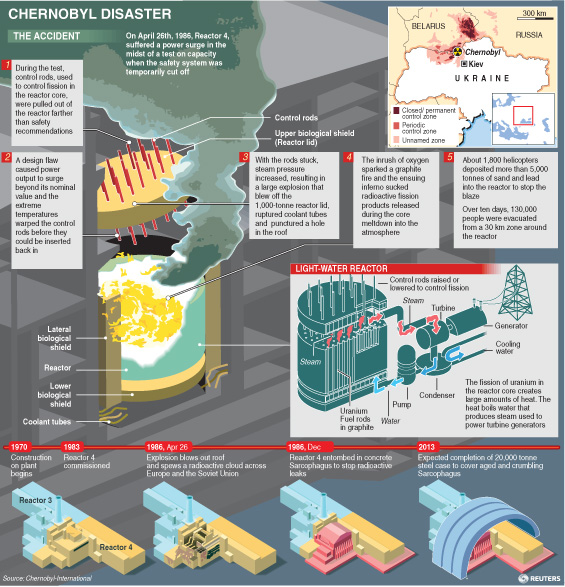Global General
Key facts on Chernobyl nuclear accident
(Agencies)
Updated: 2011-03-16 12:18
 |
Large Medium Small |
|
 3D diagrams explaining the 1986 Chernobyl nuclear disaster and planned 20,000 tonne steel case to cover its aged and crumbling Sarcophagus. [Photo/Agencies] |
KIEV - Unlike the nuclear crisis in Japan which was caused by a natural disaster, the explosion and fire at the Chernobyl power plant on April 26, 1986 -- the world's worst nuclear accident -- was caused by human error.
Facility operators, in violation of safety regulations, had switched off important control systems at the Ukrainian plant's reactor number four and allowed it to reach unstable, low-power conditions, according to a United Nations report. A power surge led to a series of blasts, at 1.24 am, which blew off the reactor's heavy steel and concrete lid and sent a cloud of radioactive dust billowing across northern and western Europe, reaching as far as the eastern United States.
Key facts:
* The cloud of radioactive strontium, caesium and plutonium affected mainly Ukraine and neighbouring Belarus, as well as parts of Russia and Europe.
* Estimates for the numbers of direct and indirect deaths from the disaster vary.
* The Chernobyl Forum, a group of eight UN agencies, and the governments of Ukraine, Belarus and Russia, have estimated the death toll at only a few thousand as a result of the explosion. UN agencies have said some 4,000 people will die in total because of radiation exposure.
* The environmental group Greenpeace puts the eventual death toll far higher than official estimates, with up to 93,000 extra cancer deaths worldwide.
* The Chernobyl Union of Ukraine, a non-government body, estimates the present death toll from the disaster at almost 734,000.
* Chernobyl engineers shut down the last functioning reactor, Number Three, in December 2000. Radioactive nuclear fuel is still being removed from the plant.
* A make-shift cover -- the 'Sarcophagus' -- was built in six months after the explosion. It covers the stricken reactor to protect the environment from radiation for at least 30 years. This has now developed cracks, triggering an international effort to fund a new encasement.
* Ukraine is seeking a further 600 million euros ($840 million) to help finance the new convex structure which will slip over the ageing 'Sarcophagus' and allow the old reactor to be dismantled.
* International donors are expected to agree to the funding at a conference in Kiev in April on the eve of the 25th anniversary of the disaster.
* Officials say it could be up to 100 years before the station is completely decommissioned.
* A 30-km (19-mile) exclusion zone is in place round the disaster site.
* Wildlife has made a comeback in this area and there are said to be more than 60 different types of mammals living there including wild boar and elk.
* Although research continues, the first reports about long-term radiation damage have been published, and the results are that the radiation did less damage than initially feared. "There is a tendency to attribute increases in the rates of all cancers over time to the Chernobyl accident, but it should be noted that increases were also observed before the accident in the affected areas," the United Nations Scientific Committee on the Effects of Atomic Radiation (UNSCEAR) said in its summer 2010 assessments of the radiation effects in Chernobyl.
"Moreover, a general increase in mortality has been reported in recent years in most areas of the former Soviet Union, and this must be taken into account when interpreting the results of Chernobyl-related studies," the report said.
* In its conclusion, the UN report said that "the vast majority of the population need not live in fear of serious health consequences due to the radiation from the Chernobyl accident".
* The report also said that the majority of the affected population in the region was exposed to radiation levels "comparable to or a few times higher than the natural background levels, and future exposures continue to slowly diminish as the radionuclides decay".
| 分享按钮 |